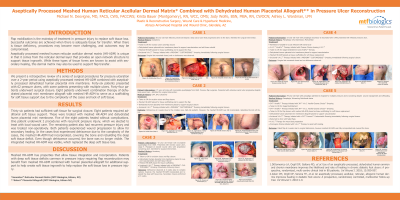Clinical Research
(CR-019) Aseptically Processed Meshed Human Reticular Acellular Dermal Matrix Combined with Dehydrated Placental Allograft in Pressure Ulcer Reconstruction

Flap mobilization is the mainstay of treatment in pressure injury to replace soft tissue loss. Successful outcomes are achieved when there is adequate tissue for transfer. When there is tissue deficiency, procedures may become more challenging, and outcomes may be compromised.
Aseptically processed meshed human reticular acellular dermal matrix (HR-ADM) is unique in that it comes from the reticular dermal layer that provides an open network structure to support tissue ingrowth. While these tissue forms are known to assist with secondary healing, this dermal matrix may also be used to support flap transfer.
Methods:
We present a retrospective review of a series of surgical procedures for pressure ulceration over a 2-year period using Aseptically Processed Meshed Human Reticular Acellular Dermal Matrix (HR-ADM) combined with Aseptically Processed Dehydrated Placental Allograft for Pressure Reconstruction.
Over the 2- year period, 46 patients presented with 62 pressure ulcers, with some patients presenting with multiple ulcers. Forty-four patients underwent surgical closure. Eight patients underwent combination therapy of placental allograft with HR-ADM to serve as a scaffolding for soft tissue support.
Results:
Five of the eight patients healed without complications. 1 patient underwent 2 procedures with recurrent pressure injury which we elected to treat with local wound care. The remaining patient also had recurrent pressure injury and was treated non operatively. Both patients experienced wound progression to allow for secondary healing.
Discussion:
Meshed HR-ADM has properties that allow tissue integration and incorporation. Patients with soft tissue deficits common in pressure injury requiring flap reconstruction may benefit from meshed HR-ADM combined with placental allograft for additional support to help create additional soft tissue ingrowth to help replace the soft tissue loss in pressure injury.

.jpeg)